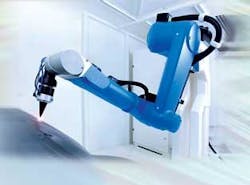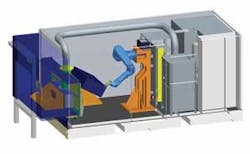Laser cutting complex parts — a challenge and solution
by Jean Pierre Bergmann and Birk Ploennigs
A simple robot-based system cuts without contact, stress, or pressure to the parts
In recent years a major trend in the automotive industry has been the increasing necessity towards more complexity in design, functionality, and mechanical strength of components.
This is particularly relevant in the context of structural or chassis parts, where complex end-parts are formed using metallic sheets with thicknesses below 2–3mm. In order to reduce the complexity and costs of the forming tool, in many cases, manufacturers decide to shift several tasks to later production steps. Therefore, tasks such as trimming of the components or adding holes are held over in the production process and have to be carried out subsequently, with high accuracy and without mechanical deformation of the components.
More traditional production processes such as cold forming and punching are based on mechanical contact between the tool and the part. These processes bear the risk of deformation and damage to the parts through the acting forces of the tools. Furthermore the automation of such processes requires robot systems with a very high robustness and stability in order to absorb the applied forces.
One alternative, fluid jet, offers several advantages that present a reliable technical solution. Major disadvantages of this method would be the necessary drying of the parts after cutting, limited cutting speed, and the required cleaning of the parts, particularly their edges.
Simple robot-based system
A more promising alternative solution is laser beam cutting with a simple robot-based system. This technology offers high flexibility and high cutting speeds without contact and without mechanical stress or pressure to the parts. Furthermore, it offers the high physical accessibility of the laser beam, high power intensity which means that the heat affected zone next to the cutting kerf is very low, and a small spot size (typically lower than 0.3mm), which allows cutting with very small kerf width. Table 1 offers an overview of punching, water jet cutting, and laser cutting.
The integration of laser procedures into highly reliable and traceable industrial processes represents the key factor for its success as a tool. The market demands, in particular, low investment costs and reasonable operating and maintenance costs. Of equal importance is a simple but effective technology with high flexibility to adapt quickly to the production of new or different products. Only after fulfilling these prerequisites can the laser be considered an advantageous tool for cutting formed metal sheet parts.
A robot-guided solution for moving the laser beam enhances the flexibility of the entire system and the physical ability of the system to reach areas of the parts that are normally difficult to access with gantry-based 5-axis systems. In addition this solution offers a higher flexibility and the simple programming of the laser lines.
Laser beam delivery key
The key challenge to the success of the integration of the laser beam in a robot-based system rests mainly in the properties of the laser beam delivery itself. A conventional solution is to couple a solid-state laser with a fiber and then to guide this with the robot to the required working position.
The disadvantage of this solution lies in the limited flexibility and integrity of the fibers caused by reflections within the fibers and by the low bending radius, which can cause mechanical damage.
In contrast a CO2 laser beam generally has a high beam quality, a small focus area, and a near-Gaussian intensity distribution in the laser spot. Therefore, the width of the cutting kerf is small (typically 0.1–0.3mm). Furthermore, the investment and operation costs for a CO2 laser are lower than those of the solid-state laser. As the working wavelength of a CO2 laser is 10.6µm, it is not possible to guide the laser beam through glass fibers but this can be achieved with guiding mirrors. This method has been successfully used already in a 3-axis system for 2D application where the laser beam is reflected through pre-positioned mirrors in the beam path.
In the past, early robot-based CO2 laser systems were developed with an external arm containing mirrors delivering the laser beam from the source to the laser head. The arm itself was guided by robot hand (6th axis) which reduced the free movement of the whole system.
Another development was the design of laser systems with a maximum output of 2000W where the laser was positioned on one of the robot axes with the laser beam delivered through defined mirrors to the laser head. In this concept the complete laser source is carried during operation with an approximate weight load of 250–300kg. This significantly restricts the mobility, accuracy, and dynamics of the system as well as having a negative influence on the accuracy for difficult laser lines under high speed. This also has a negative implication on life-time and maintenance requirements for the laser and system.
Complete optical path integrated
At Jenoptik Automation, the next generation of robot-based CO2 laser systems is presented (see Table 2), which allows laser power up to 5000W with higher accuracy and dynamics. In this system the laser is mechanically decoupled from the robot. With the collaboration of Stäubli GmbH, the laser beam is now optically coupled into the foot of the robot, thereby integrating the complete optical path of the laser beam to the tip of the laser head.
In detail the laser beam is guided by precisely fixed mirrors at the turning point of each robot axes to the front of the robot, where it is focused and delivered to the cutting head with standoff control and cutting gas inlets.
This new concept is possible because of adjustable mirrors, which are designed to be integrated into the joints of the robot. In addition all mirrors are water-cooled, which allows the handling of laser power over 5000W. In order to prevent damage to the mirror by particles, the complete beam guidance is protected by a purging pipe system (see Figure 1). The CO2 laser beam is integrated in the robot arm and has a reflection loss of less than 5% over the complete beam path.
Figure 2 shows the typical cutting speed with a Jenoptik C-BIM system and a 2.5kW CO2 laser and is a confirmation that sheet thicknesses below 3–4mm (as they are used in automotive structure) can be trimmed and cut with speeds greater than 4m/min up to 14m/min (high-speed cutting of stainless steel).
Due to this design, the robot maintains the full accuracy and dynamic properties and is very light (approx. 150kg), so that high-accuracy positioning requirements can be reached for cutting tasks for metal parts (+/-0.1mm).
It is possible to conclude that Jenoptik developed a sort of fiber delivery for the CO2 laser beam, even for the high-power sector. This solution represents a promising and reliable alternative to solid-state laser systems at lower cost and for nearly application-equivalent performance.
Integration for industrial practice
The company went a step further integrating the robot, the laser, and the chiller on a platform to a compact processing cell, in
order to fulfill requirements of industrial practice. Figure 3 shows one solution where loading and moving of the component occurs through a turntable, while the laser system, filter, and so on are positioned on the rear of the cell. The cell itself can be easily moved as one single unit without requiring much re-adjusting. Typical size of handled parts is up to 1400mm × 700mm × 500mm, while platform and cell dimensions are approx. 5.20m × 2.20m × 2.30m (power up to 600W) and approximately 5.90m × 2.20m × 2.30m (power greater than 600W).
The combination of two robots, with one laser and a beam splitter or with two lasers, in one processing unit represents another approach especially for processing large parts, parts with high complexity and difficult accessibility, or applications with low cycle time requirements.
These compact concepts possess a great deal of flexibility and represent an optimum solution for companies that need a flexible cutting system to carry out recurrent high-grade jobs that are not identical.
Conclusion
The recent increasing trend towards automation of cutting processes, particularly for 3D processing, represents a challenge for automation companies. High accuracy and flexibility, fast cutting speeds, fit-for-purpose beam guidance concepts with reasonable investment cost, and compact design are the focus of interest. Jenoptik provides a laser system that fulfills these requirements and offers a versatile, applicable alternative to existing laser cutting systems.
Reference
1. Introduction to industrial laser material processing, Rofin 2004.
Dr.-Ing. Jean Pierre Bergmann ([email protected]) is with Jenoptik Automatisierungstechnik GmbH, Jena (Germany). Birk Ploennigs ([email protected]) is with Jenoptik UK Ltd., UK.
This article first appeared in The Laser User magazine. It is printed with permission.





